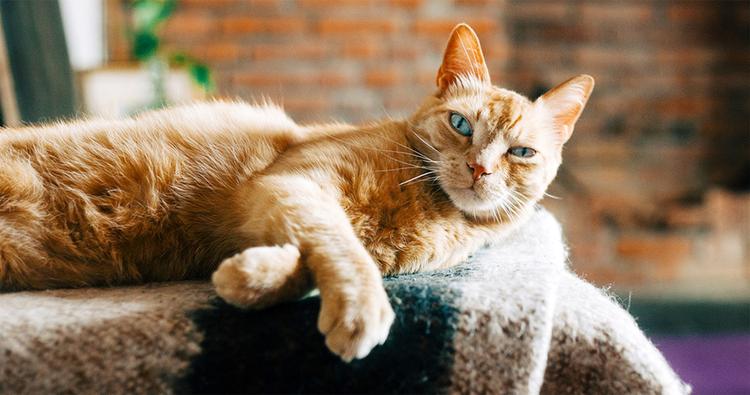Things I Wish I Knew Before Getting a Second Cat
Thinking about adding another cat to your home? Here’s how to expand your family, minus the drama.
Thinking about adding another cat to your home? Here’s how to expand your family, minus the drama.
by Katie Koschalk, | June 15, 2024

Gillian Vann / Stocksy
You might think cats are solitary pets. The truth is, though, that cats and kittens can get lonely. But while adopting a cat is a big commitment, adopting a second cat is an even bigger one. From potential issues with compatibility to increased financial responsibilities, the decision to expand your feline family requires careful consideration and planning. Let’s explore the pros and cons of getting a second cat in greater detail.
We’ll start with the good stuff. Here’s why it may make sense to add another cat to your home.
One of the top reasons people get a second cat is for companionship — not only for you, but also for your existing cat. While this differs from cat to cat, some thrive in the company of fellow kitties. This might be especially beneficial if you’re away from your home for several hours during the day or night.
As much as you’d like to spend hours playing and cuddling with your cat, the demands of daily life usually get in the way. If your cats get along, they’ll likely entertain each other through play or simply being in each other’s presence.
When cats lack stimulation, their boredom can manifest as behavioral issues, such as clawing at your furniture, overgrooming, or excessively asking for attention or play. Having a second cat can help alleviate this.
Next, let’s review the potential cons. If you’re debating getting a second cat, it’s best to consider two things first: Can you provide a feline duo with proper care and attention, and will your current cat benefit from the companionship? (Watch out for territorial or aggressive behavior in the latter, which can be a deal-breaker.) Here are the things pet parents probably wished they knew before getting a second cat.
Cats can be solitary creatures, or they can be social animals. It depends on the cat. Those who have lived together since birth or kittenhood will typically get along, but introducing unfamiliar adult cats to each other is a mixed bag. Some might become friends (or at least learn to coexist peacefully) over the course of several months, but others never do. In unfortunate cases, some cats fight when introduced — even when a proper introduction protocol is followed — and continue to do so until one must be rehomed.
Cats are territorial animals and don’t like sharing or waiting for anything. To express their need for space and ownership of resources, they may spray (a.k.a. urine mark). It’s their way of warning other cats to back off, without a direct confrontation. They might also display resource-guarding behavior, including hogging food, litter boxes, and your attention.
Adding a second cat to your family means doubling the financial responsibility. It’s essential to consider if you have the budget to accommodate the additional expenses before bringing home a second cat. (More on this shortly.)
Introducing a new cat into your home can pose potential health risks to both your existing cat and the newcomer. More pets mean more curious living, breathing beings who can pick up bugs — and spread them. Ensuring both cats are in good health before introducing them is vital, as is staying up-to-date on their vaccinations and regular veterinary check-ups.
Before making the decision to add another cat to your family, it’s crucial to face some realities. Consider this your “Should I Get a Second Cat?” quiz.
Is my current living situation suitable for another cat?
Evaluate your living space, and consider whether or not it can comfortably accommodate the needs of another cat. This includes space for feeding, extra litter boxes, more cat trees and scratching posts, and areas for play and rest.
Can I afford the additional expenses associated with a second cat?
Make sure your budget can handle the added expenses of a second cat without causing financial strain. The ASPCA estimates that the average yearly cost of being a parent to one cat is $1,149. That includes all the regular food, supplies, and services you need to raise a happy, healthy cat. With the addition of a second cat, you should anticipate doubling that amount. Keep in mind that this estimate does not account for unforeseen expenses, such as veterinary care for accidents or illnesses.
Will my current cat get along with a new cat?
Observe your cat’s interactions with other felines, whether it’s during a visit to the veterinarian or while seeing a neighbor’s cat outside your home. Do they appear relatively unbothered? Or do they exhibit signs of aggression, such as growling or hissing? These behaviors provide insight into how your cat might respond to the introduction of a new cat.
Does my family or roommate want another cat?
If you live with other people, whether it’s family or roommates, discuss the idea of getting a second cat with them. Since you may need help taking care of two cats (and because household dynamics can affect your pets’ well-being), everyone should be on board with the decision.
Do I have rental stipulations that prevent additional pets?
If you rent your home, review your rental or lease agreement to determine if there are any restrictions on multiple-pet ownership.
Do I have the time and patience to introduce a new cat into my home?
Integrating a new cat into your household takes a lot of effort. The introduction process typically takes three to six weeks and requires constant assistance and monitoring on your part. After that initial process, cats can take as long as a year to truly acclimate to each other, assuming that happens at all.
Can I commit to the long-term care of multiple cats?
Adopting a cat is a commitment, often lasting 15 years or more. It’s imperative that you’re prepared to take care of multiple cats throughout their lives.
If you’re ready to get a cat, next consider the needs of your current cat. Several clues may suggest that adding a second cat would benefit your resident cat. These signs include:
Loneliness or boredom: If your cat frequently displays signs of loneliness, such as excessive meowing, attention-seeking behavior, grooming, or destructive behavior, they may benefit from the companionship of another cat.
Separation anxiety: If your cat becomes significantly distressed when you leave (as observed on a cat cam), the company of another cat could calm them.
Your cat’s temperament: If your cat has a more relaxed, go-with-the-flow personality, a feline friend could work out well. However, if your cat is territorial, solitary, or easily stressed by changes in their surroundings, getting a second cat might not be the best choice.
Your cat’s age: Kittens and younger cats typically adjust quickly and easily to the presence of a new cat in the household. But adult and elderly cats are more set in their ways and may have difficulty acclimating to a new addition.
So, you’ve determined that getting a second cat is the right choice. Now what? Here’s how to find and choose the perfect addition to your feline family.
Most cat experts advise introducing a new cat who aligns with the existing cat’s energy level, size, and personality. For instance, adopting an energetic kitten might not be ideal if your resident cat is a low-energy senior. The kitten may feel lonely without a suitable playmate, while the older cat could become annoyed and stressed by constant requests to play.
What about the gender of your second cat? There’s no evidence to suggest cats prefer one gender over the other. Temperament is most important.
Now comes the fun part: finding your new family member. You might want to visit rescues or shelters in person. Or you can search online on various rescue, shelter, or adoption-service sites. For instance, you can search for cats on Adopt a Pet based on several criteria, including location, age, gender, color, hair length, health, and even if they’re good with kids, dogs, and other cats. Once you find a cat who seems like a good fit, arrange a meet-and-greet.
For even more details, check out our step-by-step guide on how to adopt a cat.

Studio Firma / Stocksy
Creating a positive initial experience is crucial when introducing a new cat to your household. Rushing the process can lead to conflicts that may hinder peaceful cohabitation in the long run.
Step 1: The first step involves setting up a sanctuary room for the new cat, furnished with essentials like food, water, a bed, and toys. To initiate the introduction process, start by feeding the cats on opposite sides of the closed sanctuary-room door, gradually moving their food dishes closer with each meal. This helps them associate the pleasant activity of eating with each other’s presence.
Step 2: Once they’re eating calmly with their dishes directly on each side of the door, you can proceed to allow them glimpses and sniffs of each other through a cracked door or room divider. From there, swap sleeping blankets (or other items saturated with the cats’ scents) between your new cat and your resident cat. This can help them become better acquainted with each other’s scent.
Step 3: If both cats are showing promising signs of socialization, you can begin short, supervised meetings, gradually increasing the time they spend together each day. It’s normal for there to be some hissing, growling, and puffy tails. But if aggressive or fearful behavior escalates, separate the cats and try again later. The goal is to create positive associations between the cats.
For a more comprehensive breakdown of the cat introduction process, see our guide.
Avoid getting a new cat right after the death of one of your cats. Observe your other cat’s behavior for a few months. If they adjust and seem happy, it might be best to avoid getting another cat — because why introduce a possible source of stress? But if they seem withdrawn or depressed, getting them a new companion could boost their spirits.
Introducing a new cat to your existing cat requires patience and planning. Start by isolating the new cat in a separate room with all the necessary amenities. Gradually add scent-swapping and visual introductions, then progress to supervised interactions. For more detailed steps, refer to our section, above, on “How to introduce a second cat to your household.”
That depends on the individual cat. Some cats thrive with the companionship of another cat, while others may become stressed or territorial. Consider your cat’s personality and needs first, before bringing home a second cat.
Think your resident cat would like a friend? Use the Adopt a Pet search tool to find your new family member today.
Aggression Between Cats in Your Household
Fast Game Theory Coupled to Slow Population Dynamics: the Case of Domestic Cat Populations
The Impact of Behavioral Plasticity at Individual Level on Domestic Cat Population Dynamics
A Review of over Three Decades of Research on Cat-Human and Human-Cat Interactions and Relationships

Katie Koschalk is a freelance writer based in Northern California. Fusing her love and knowledge of animals with her journalism degree and years of professional writing, Katie is dedicated to improving the lives of pets and their caretakers by sharing helpful and accurate information. When she’s not at her desk, you can find her exploring trails with her Aussie, Hunter, cooking plant-based meals, and talking to her two cats, Jax and Sadie, in really ridiculous voices.

Behavior & Training

Breed Info

Foster & Volunteer

Adoption Advice
Considering renting with pets? Read more to learn about renter policies and how to navigate them.